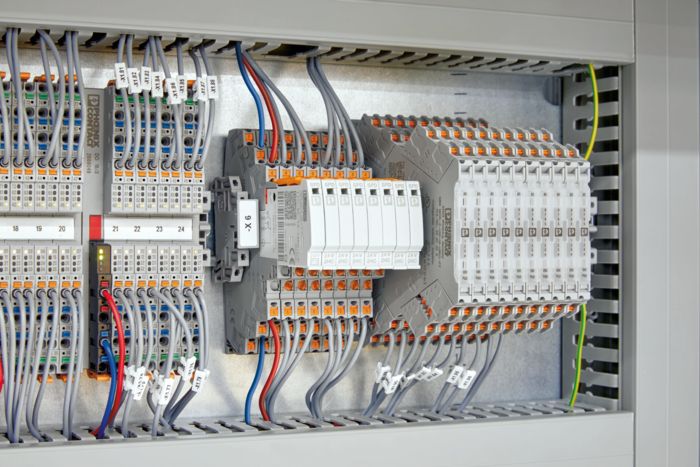
Isolating spark gap


Surge protection refers to the protection of systems and electrical devices against excessively high voltage peaks caused by switching operations and lightning strikes. An effective lightning protection strategy combines internal and external lightning protection. Protect the power supplies, data, and signals in your system. Use the reliable surge protection solutions available in our various product ranges as part of your internal lightning protection strategy.

FLT SEC type 1+2 special surge protection in the main distribution
Our type 1+2, type 1+2 special, type 2, or type 3 surge protective devices provide effective protection for your electronic devices. From feed-in to the end device, we offer convenient, ready-to-install solutions for all applications.

Narrow surge protection for signals in the control cabinet
A large number of signals are controlled and monitored in measurement and control technology (MCR technology) applications. Our protective devices prevent malfunctions and damage caused by surge voltages and offer an ideal solution for any application.

DT-LAN protects against surge voltages from the data network
Data interfaces are particularly sensitive to surge voltages, because they operate with low signal levels and high frequencies. Use our surge protection solutions for interference-free data transmission while maintaining the bandwidth in your IT systems.

C-SAT-BOX protects connected TV and HiFi equipment against surge voltages
Transceiver systems are particularly at risk from surge voltages. Antenna cables that extend beyond the building and the antennas themselves are directly exposed to atmospheric discharges. Play it safe with our powerful, coaxial surge protective devices.

Surge protection for photovoltaic systems
Photovoltaic systems place special demands on surge protection, e.g., regarding air clearance and creepage distances and the different types of voltage that must be considered in photovoltaic systems. We provide you with the right components for your PV applications, from ready-to-install string combiner boxes through to individual surge protective devices.

ImpulseCheck monitors type 1+2 special surge protective device in the main distribution
ImpulseCheck is the world’s first intelligent assistance system for surge protection in the field of mains protection, allowing you to monitor your systems in real time. The system permanently records the state of the relevant system. The state of health of the surge protective device is known at all times, so you can prevent a failure in good time.
To manually test pluggable surge protective devices in accordance with the requirements of IEC 62305, use CHECKMASTER 2 as a mobile test device. You can prevent machine and system failures by performing periodic precautionary checks.

Isolating spark gap for discharging surge voltages on an insulating flange
When high voltages occur for a short period (for example, due to a lightning strike), isolating spark gaps connect metallic exposed conductive parts which must not be permanently galvanically connected during operation. For example, protect sensitive insulating flanges in pipelines against sparkover and avoid failures, downtimes, or leaks.

With our CHARX protect surge protective devices, you can protect charging stations and electric vehicles against damage due to surge voltages which can arise due to lightning strikes or switching operations in the grid. Charge without risk by ensuring that your charging infrastructure remains available at all times - at any time of the day or night, and in any weather.

Protective circuit principle and protection concept
You should plan a protection concept for lightning and surge protection so that all cables, devices, and systems are protected.
The protective circuit principle is easy to illustrate:
Draw an imaginary circle around the object you want to protect. Surge protective devices must be installed at all points where cables intersect this circle. This ensures that the area within the protective circuit is protected in such a way that conducted overvoltages are prevented.
When planning the protection concept, consider the following areas of application:
An effective protective circuit helps ensure seamless surge protection.

Surge protection standards
National and international standards provide a guide to establishing a lightning and surge protection concept as well as the design of the individual protective devices. They differ depending on region and field of application. The overarching standard is lightning protection standard IEC 62305. It describes protective measures against lightning events and an extensive risk analysis with regard to the necessity, scope, and cost-effectiveness of a protection concept.